Leapin’ lizards – that ain’t no ordinary lizard!!
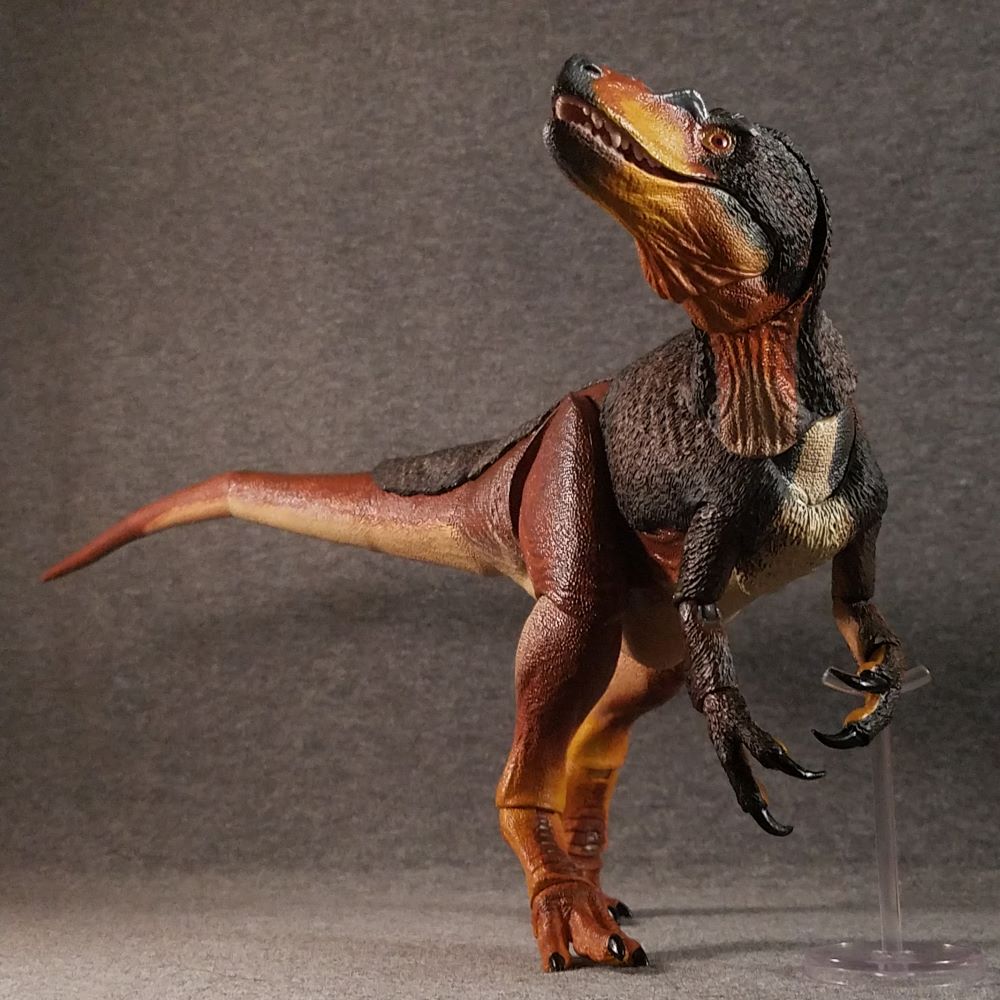
If you had to choose just one of Charles R. Knight’s influential and iconic paleoart pieces as his very greatest work, which one would you pick? Out of all Knight’s incredible paintings, the one I personally find most captivating is the 1897 “Leaping Laelaps“, a vivid illustration of two large theropods pouncing upon each other in what could be either play-fighting or serious combat. Despite their bulky, reptilian appearances, the dinosaurs are presented as much more dynamic and energetic than usual for depictions from the 19th and early 20th centuries. “Laelaps” itself is not a name you’ll hear often anymore, for a couple of reasons. One: there were other, more complete theropods discovered which easily took the media spotlight. Two, and more importantly: the dinosaur “Laelaps” is no longer actually called “Laelaps”, due to that genus name having already been given to a type of mite. The subjects Knight depicted in his work now belong under the genus name Dryptosaurus, or “tearing lizard”. This circumstance probably sounds funny, but this isn’t the only time a dinosaur lost its name to an invertebrate. Producing a unique scientific name isn’t always easy!
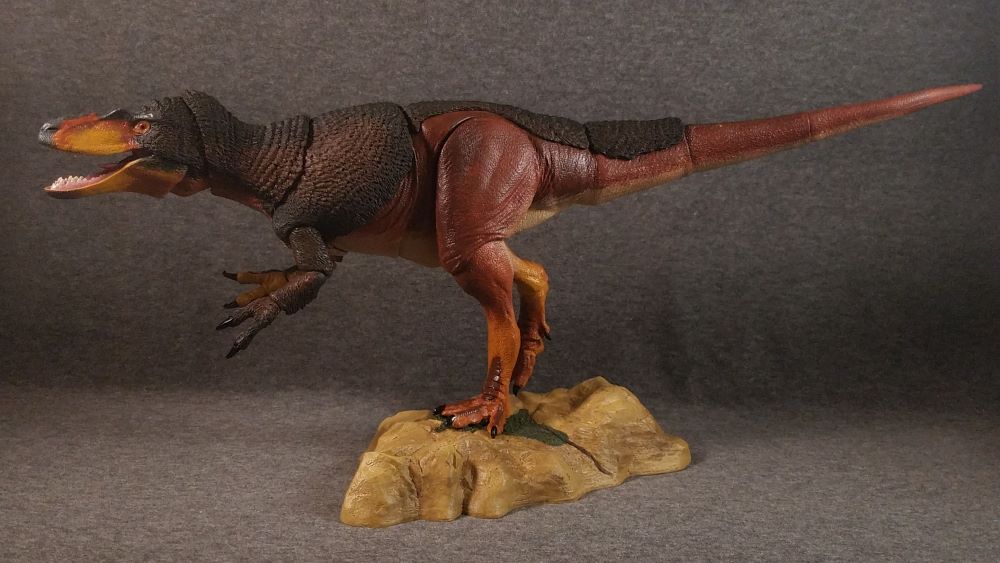
Although the name has changed and its fossils remain fragmentary, there are plenty of reasons why Dryptosaurus is still an interesting dinosaur. For starters, Dryptosaurus is classified today as a tyrannosauroid – which is usually a good name for association when it comes to dinosaur publicity. Dryptosaurus was also one of the last giant theropods to roam the earth; its fossils date back to 67 million years ago, just 1 million years before the K-Pg extinction event. This late-game Cretaceous predator was, conversely, the very FIRST theropod dinosaur ever discovered in North America; and it remains one of very few dinosaur genera known from the Eastern United States. The name “tearing lizard” references the 8-inch hooked claws which tipped the dinosaur’s fingers, extended from arms that were unusually large for a tyrannosauroid. Dryptosaurus might have relied on a more balanced grappling style of capturing prey than its more robust relatives in the west, who sacrificed arm length for extreme skull power.
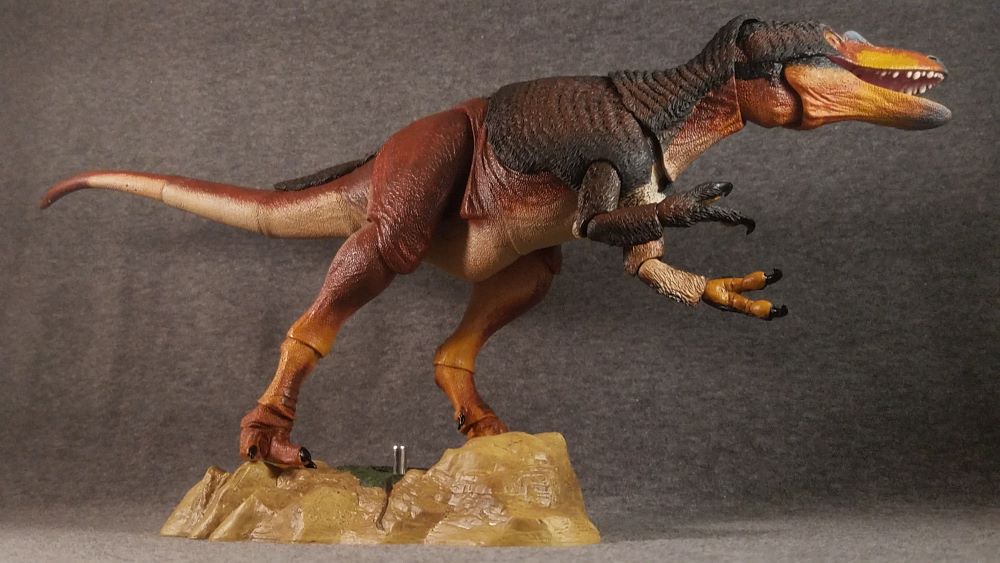
The lack of fossil material and media publicity probably explains the similar lack of Dryptosaurus-related merchandise, which makes the deluxe action figure from Beasts of the Mesozoic all the more remarkable in its arrival last year. Dryptosaurus is the 8th action figure in the Tyrannosaur Series and was released as part of wave 2 in August 2023, after roughly two years of process in crafting, Kickstarter pledges, and factory finalization. The completed product was one of my most anticipated releases from the Beasts of the Mesozoic line, and one of the most exciting toy releases of 2023 for me in general. The question was, once I finally held the figure in my hands: was the wait for this figure worth it? Let’s take a look and find out (spoiler alert: yes).
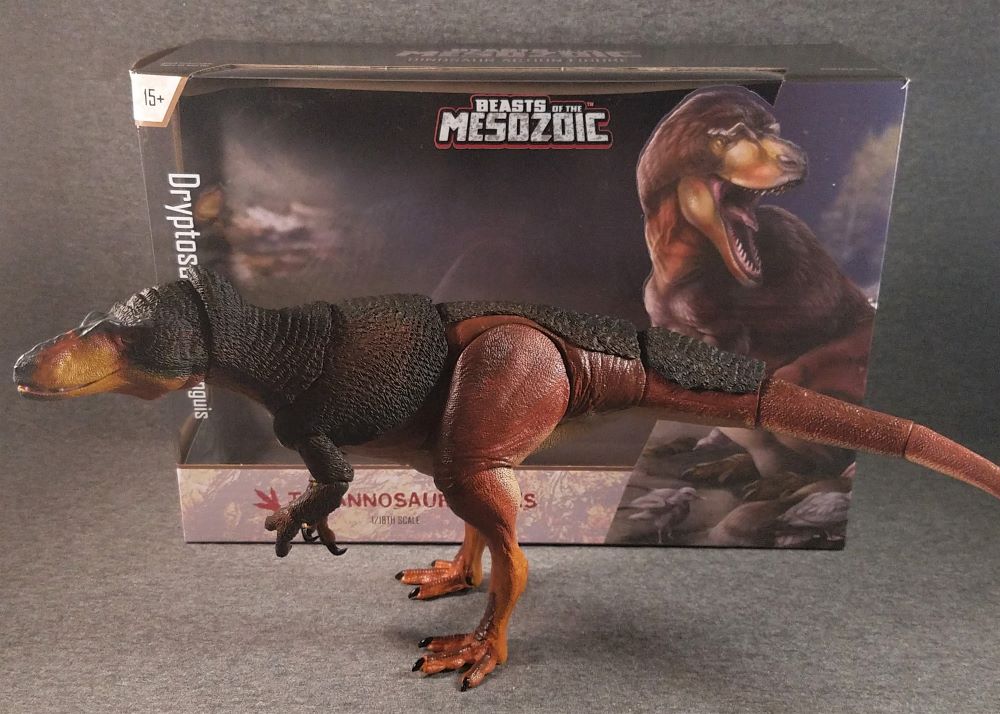
Designed and sculpted by David Silva and Jake Baarose, the Beasts of the Mesozoic Dryptosaurus figure measures 42 cm/16.5 in from nose to tail, placing the figure comfortably within the advertised 1:18 scale for a 7.5-meter/25-ft adult specimen. The sturdy packaging features artwork on the front by Shannon Beaumont, which is also featured on the collectible card within. The back of both the box and the card feature scientific stats for the animal, as is the standard for the line. Inside the cardboard box, the main figure is accompanied by a display base, a pair of articulated lower legs, and two extra pairs of feet for posing. Everything is tightly secured, and my copy appeared free of any scuffs from transit.
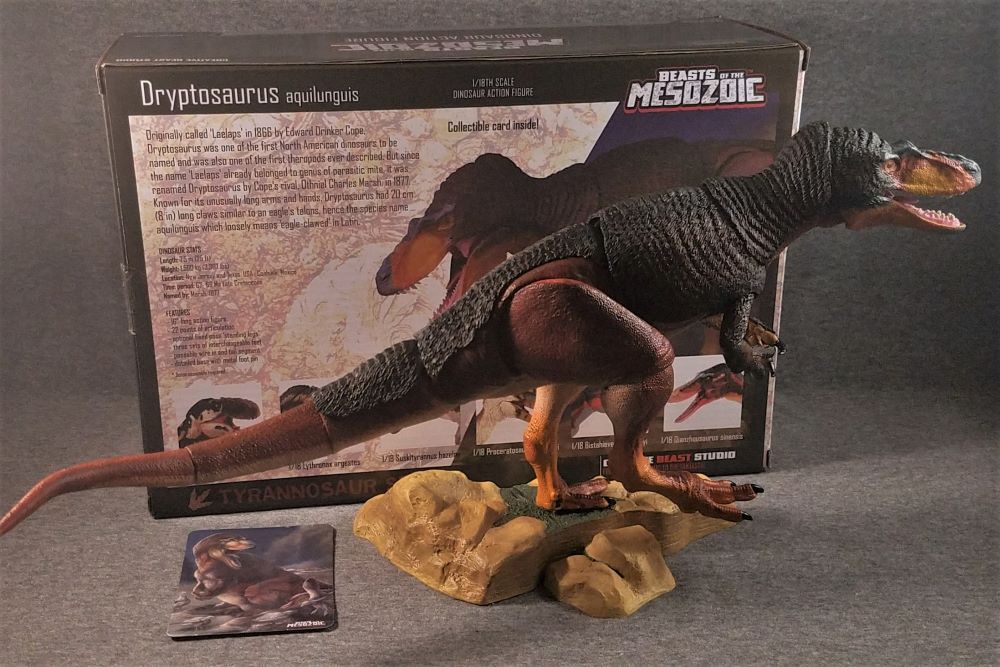
Since fossils for Dryptosaurus are so scarce, much of the animal’s appearance has to be inferred from possible relatives such as Eotyrannus and Appalachiosaurus. We do have most of the leg accounted for, and the proportions from femur to tibia to metatarsals (IE, the thigh/shin/midfoot) look very close on the sculpt when compared to skeletals; possibly the tibia could afford to be a little longer (it’s hard to be precise, of course, when measuring through the “flesh” of the figure). The skull is very reminiscent of Appalachiosaurus, and displays the subtle features recognizably seen in so many tyrannosaurs – such as the rounded lacrimal crests above the eyes, and the raised nasal ridge farther down the snout – while being starkly shallower and less robust in appearance than the more advanced lineages. Although BotM’s tyrannosaurs are fully lipped, Dryptosaurus bears some formidable-looking teeth behind its jowled jaws all the same. The arms are substantial in length, with a manus and digits that are longer than either upper or lower arms and end in wickedly sharp meat-hooks (they really are quite pointy – friendly reminder that this is intended as an “adult” collectible rather than a kid’s toy). The torso is deep, but trim, and the tail is of ample length. A pelt of short feathers covers the front of the body and the spine, with the hind legs and most of the tail appearing scaly. There’s a coarseness to the rows of feathers which I appreciate, the texture suggesting an organic layering of folded skin and muscle underneath. The extent of feathering on large theropods remains an area of mostly speculation, so collectors can decide for themselves how reasonable this approach seems. I think the way it’s sculpted works well, and reminds me of how ostriches, despite their shaggy plumage, can still have bare-skinned muscular legs. Perhaps Dryptosaurus would have benefited from a similar integument in its environment.

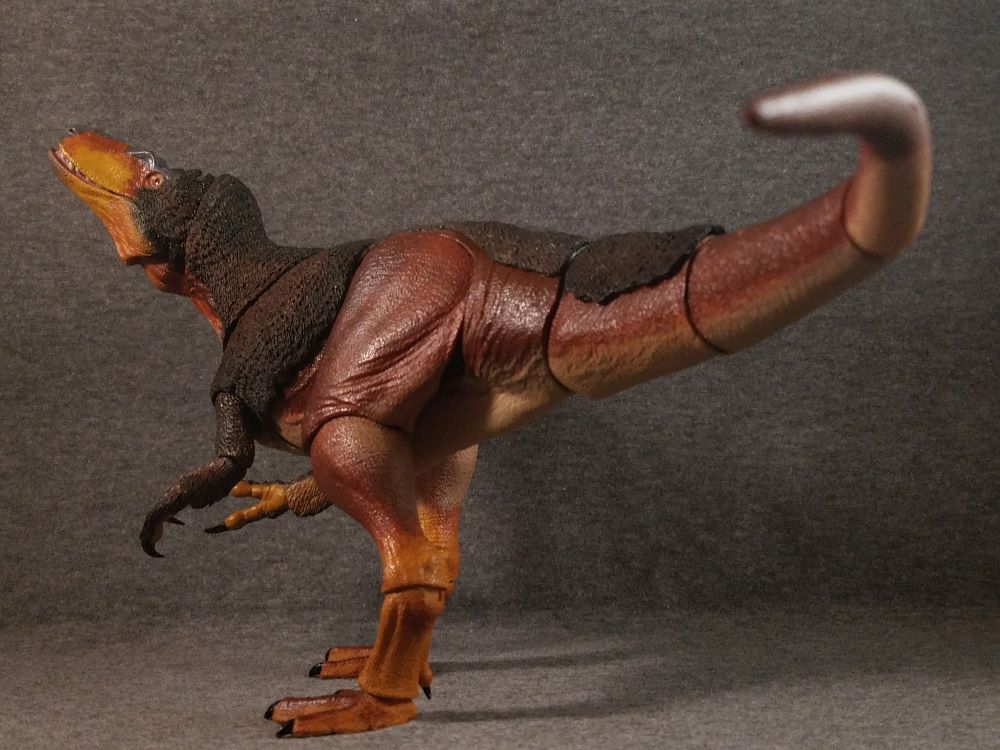
Prior to receiving Dryptosaurus, my only figure from the Tyrannosaur Series was the 1/35 Tyrannosaurus, which is no slouch of a figure itself; however, I was pleased to notice Dryptosaurus had a leg up in the articulation department. The 22 points of articulation are essentially the same, but the sculpt and engineering works in Dryptosaurus’s favor here and there, albeit still with some imperfections. The Double-ended neck ball joint allows about 60 degrees of movement to the left and right, and at least as much movement upwards; however only a few degrees downward motion are feasible. Dryptosaurus can peer into the sky and take a good sniff of the air, but I await a figure that can properly bend down to pose for feeding. Thankfully the torso ball joint can help a little. The jaw is a standard hinge, but for some reason my copy is… Spongy?? Dryptosaurus has difficulty holding its mouth fully closed or open; rather than too loose, I wonder if the hinge on mine is too tight. If anyone else has encountered this quirk I’d be interested to know.
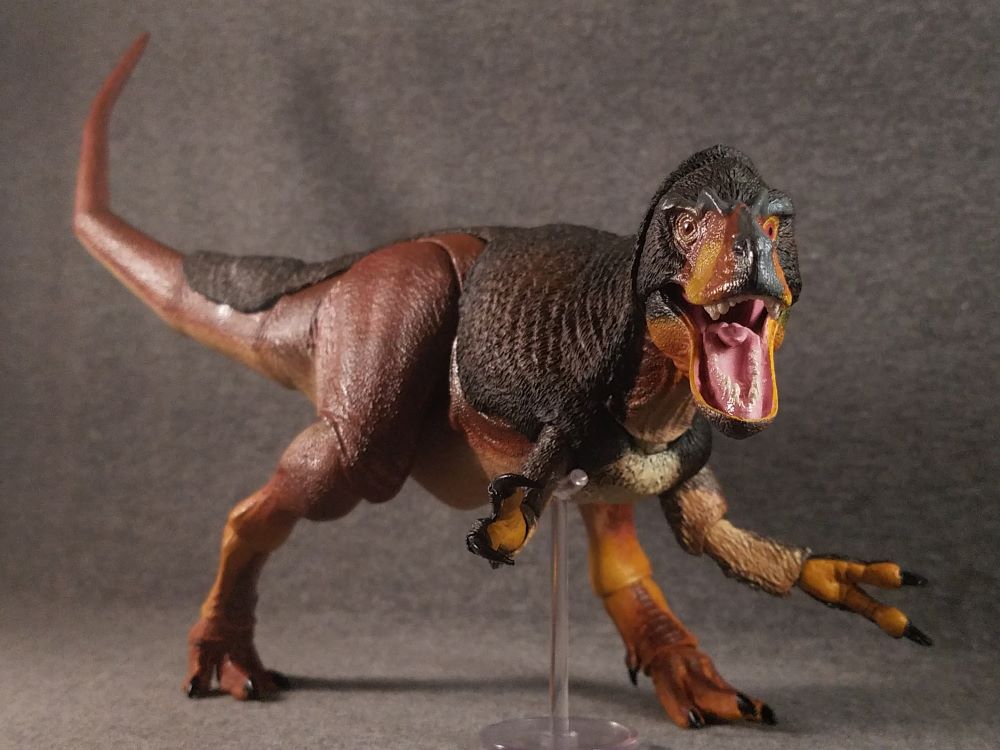
Since Dryptosaurus has proportionately larger arms than T. rex, the arms on this figure are also much more versatile. The shoulder joints can’t quite pivot flush to the body, nor can they spread to the sides much; however they can be swiveled well enough to get a nice grappling spread with claws out wide. The hips, meanwhile, can swivel close to 180 degrees, which is excellent for action poses. The knee and ankle joints are very cooperative after a little working and blow-dryer treatment, although I do wish the knees could bend further than they do. I’ve also found the neutral foot pieces can become a little too loose and have a harder time holding the figure’s weight; the additional foot parts have not exhibited this issue so far. Three ball joints are featured in the tail, with the third section also featuring a bendy wire. Although I’m tempted to say at least one more tail joint would be ideal, the range of motion is quite satisfying. Overall, because Dryptosaurus is a much more slender animal, the figure can achieve just enough extra degrees of motion to get some very expressive and playful poses. Coupled with its wolflike visage and toothy “smile”, and Dryptosaurus has been an incredibly fun figure to play with.
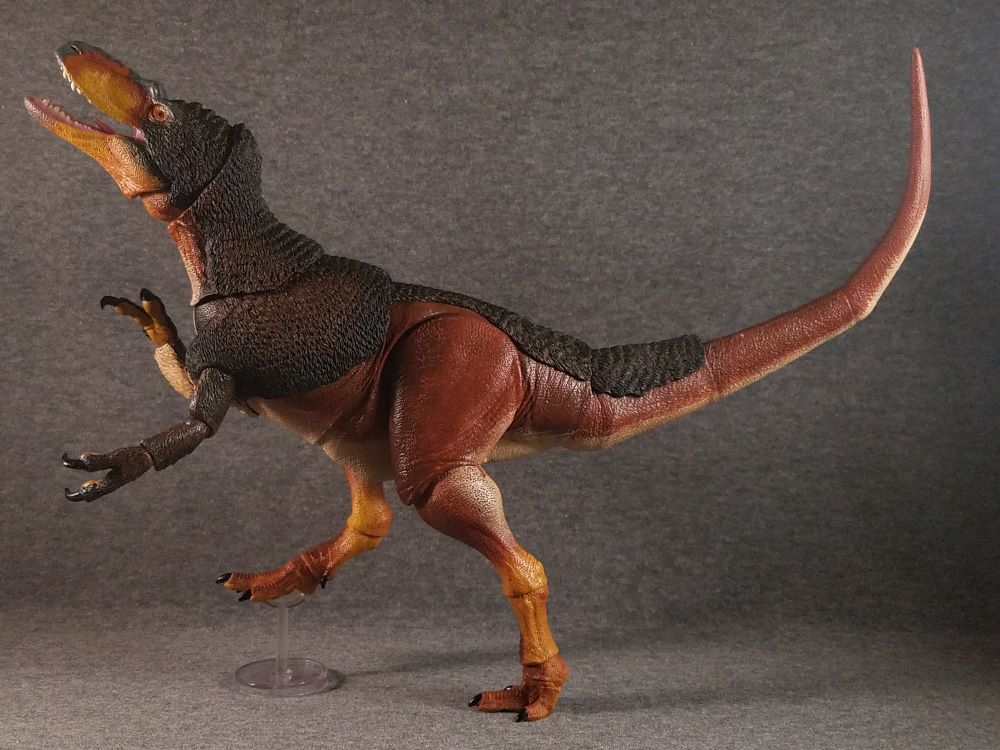

Dryptosaurus has one of the more restrained color schemes in the Beasts of the Mesozoic line, based on the plumage of the Western American raptor, the Harris hawk. The result is no less attractive for it, though: rich, dark ruddy-brown flanks and reddish-black feathers dominate most of the pattern, with shades of yellow and orange highlighting the facial features, hands, and feet. The eyes are a muted blood-red, with sold grey for the orbital and nasal ridges, and a heavy cream hue dissolving over the belly. The tones all match nicely, subdued but not dull, with neat blending of hues and faint washes of black and red on alternating body parts to create a balanced color scheme; the result giving Dryptosaurus a beautifully rugged and formidable presence befitting a swift, deadly tyrant hunter.
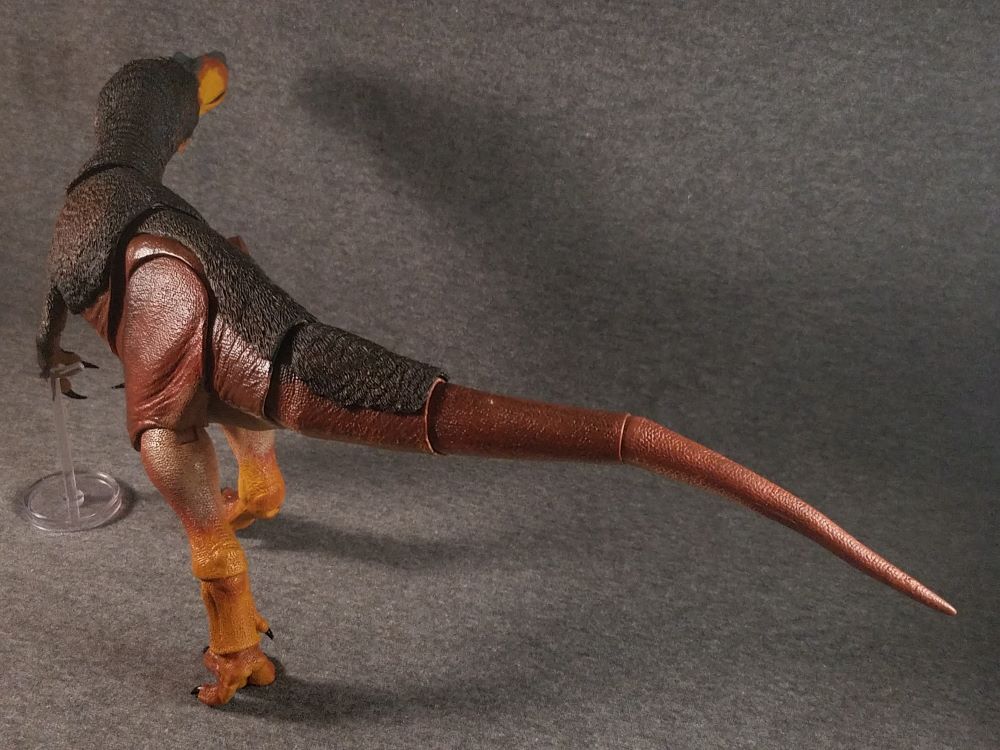
When David Silva began the Beasts of the Mesozoic line, he set out to pave new ground in the toy dinosaur market. For Dryptosaurus, one of North America’s first-ever discovered dinosaurs, that new ground was laid several layers deep; this is one of the first replicas of the Late Cretaceous tyrant in the market, and delivered in a deluxe, scientifically rigorous presentation to boot. Beholding this figure has given me new interest and appreciation for this historical genus, and if that isn’t the best thing a toy dinosaur can do, I don’t know what is. Barring a few quirks in the articulation, this figure comes highly recommended. You can currently find the figure on the Creative Beast website shop directly, as well as several online retailers including Happy Hen Toys and Everything Dinosaur.
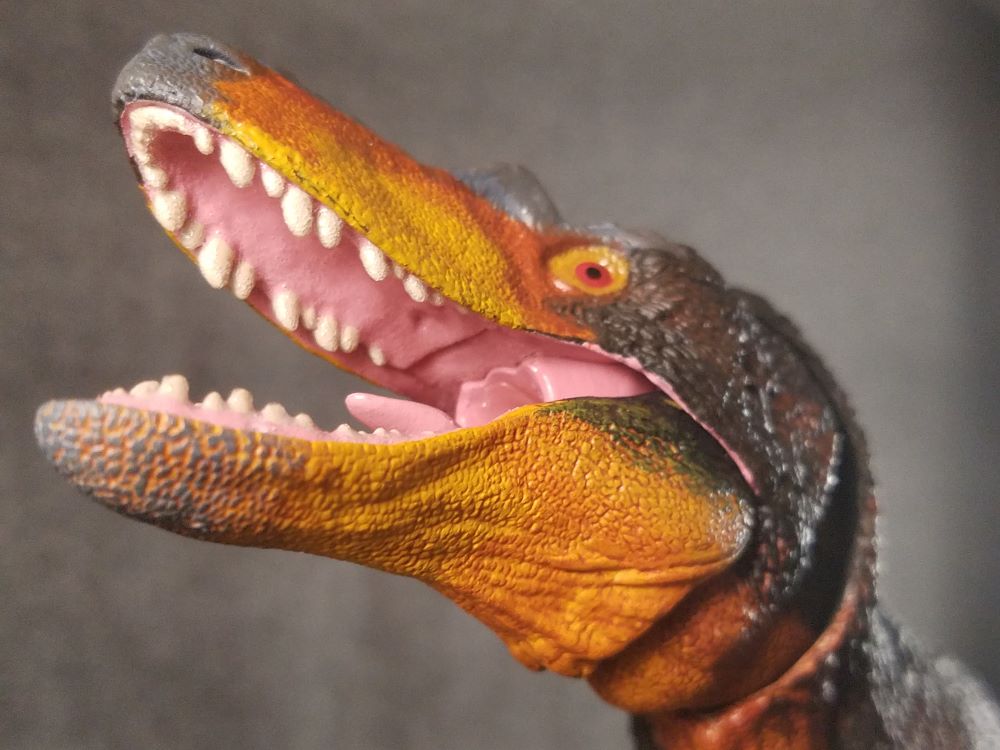
Disclaimer: links to Ebay and Amazon on the DinoToyBlog are affiliate links, so we make a small commission if you use them. Thanks for supporting us!




I am hoping to get this before the end of the year.
I ordered the Cyberzoic version of this beastie via the kickstarter and I can’t wait!
Great review! Makes me wish more companies would tackle this genus.